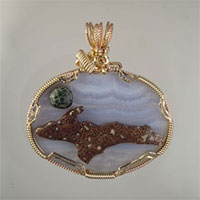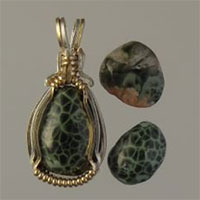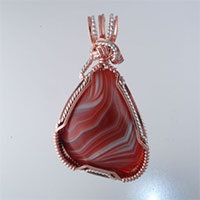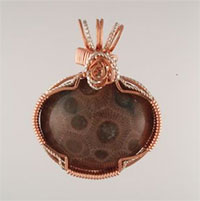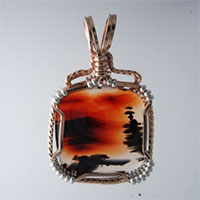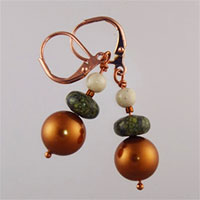Definitions
Adularescence is the main phenomena of Moonstone. This effect is an opalescence which moves on the surface of a cabochon when turned in light.
Argentium is a new, highly tarnish resistant sterling silver that keeps its shine for years without polishing. See the “Our Jewelry” link for more information.
Asterism is also known as “star effect”. We see this effect in Sapphire, Ruby, and Garnet on occasion. Rutile or other minerals cause this star. Stars can be crossed, 4, 6, 8 points or more.
A Bail is the part of the slide or pendant that allows a chain or cord to pass through. The size of this determines how big a chain you can use, for example. Usually a smaller pendant has a smaller bail, because it would look best on a smaller chain.
Chatoyant means varying in color when seen from different angles, a changeable luster, as if you were seeing different layers, such as you see in tiger eye, or Victoria Stone.
Dendrites refer to minerals crystallized in another mineral, looking like a branch or tree.
A Doublet is comprised of two parts, with a gemstone material on the bottom, covered with an optical quartz cap in most cases. The cap magnifies, protects, and enhances the gemstone.
Faceted means cutting a gemstone in a sequence of flat polished surfaces. This brings out the brilliance of transparent stones such as diamonds. We might use soft faceting on a stone such as Petoskey, meaning that they are not sharp angles, but slightly rounded.
Gold Plate findings have gold that has been electroplated on a material in a thin layer of controlled thickness. We do not use products that are gold plate.
14/20 GOLD FILLED WIRE (ROLLED GOLD) 14/20 Gold-filled jewelry wire is made by pressure bonding a thin layer of 14 karat gold over tarnish-free brass. Fourteen karat gold is too soft to hold a cabochon properly, so brass is used on the inside of the wire for strength. The 14/20 refers to the 14 karat gold that covers the outer surface of the wire, and the 20 in the 14/20 means that 1/20th by weight of the wire (or 5%) is 14 karat gold. There is 100 times more gold in 14/20 wire than on gold plated jewelry. This wire will last a lifetime under normal use. 14/20 wears just like 14 karat gold and only people with extreme sensitivity have any allergic reactions. Many of these reactions are caused by nickel found in cheap plated wire. If you can wear 14 karat gold, you should be able to wear 14/20 gold- filled wire. All our wire is nickel free.
Gold Fill beads and clasps are made by combining a layer or layers of 14kt gold alloy to a base metal (usually brass), then rolling or drawing the metal to the desired thickness or shape. Gold-fill beads and clasps have a long life and can be worn by most people without difficulty.
Inclusions are minerals that may be present in a stone. Included minerals may be older, formed at the same time, or younger than the host crystal. For our purposes we look for inclusions that add interest and character to the host stone!
Iridescence in a light dispersion caused play of color generally caused by internal cracks, strains, or flaws in a stone.
Labradorescence is a metallic like play of color across a stone. Labradorite/Spectrolite are the primary minerals with this effect.
Opalescence is a pearly effect, normally milky blue, appearing on a gem.
Sterlingand silver are used interchangeably on this web site, both refer to .925 sterling silver.
A Triplet is comprised of three layers, with a thin slice of gemstone material in the middle of the sandwich. The gemstone is generally covered with as optical quartz cap. The cap magnifies, protects, and enhances the gemstone. The bottom layer may be a natural or composite material.
Opalization is a play of color change at varying angles and lighting.
Vermeil is 22 kt gold layered over sterling silver (100 millionths of an inch), resulting in a coating 50 times heavier than standard gold plating (2 millionths of an inch).


